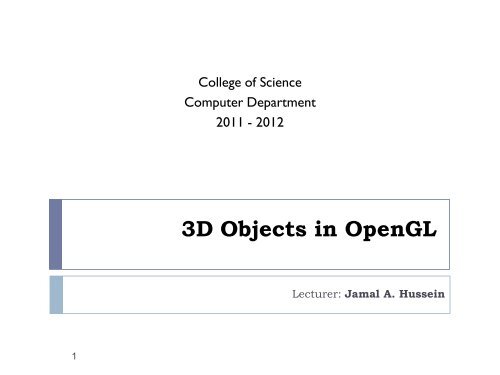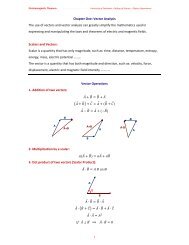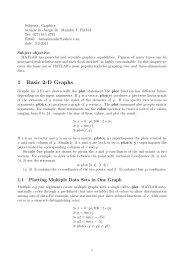3D Objects in OpenGL
3D Objects in OpenGL
3D Objects in OpenGL
Create successful ePaper yourself
Turn your PDF publications into a flip-book with our unique Google optimized e-Paper software.
College of Science<br />
Computer Department<br />
2011 - 2012<br />
<strong>3D</strong> <strong>Objects</strong> <strong>in</strong> <strong>OpenGL</strong><br />
Lecturer: Jamal A. Husse<strong>in</strong><br />
1
GLUT <strong>3D</strong> Shapes<br />
import com.sun.opengl.util.gl2.*;<br />
//Enable Light<strong>in</strong>g<br />
glEnable(GL_LIGHTING);<br />
glEnable(GL_LIGHT0);<br />
glEnable(GL_COLOR_MATERIAL);<br />
…<br />
GLUT glut = new GLUT();<br />
…<br />
glut.glutSolidTeapot(0.5);<br />
glut.glutWireCube(1.0f);<br />
glut.glutSolidTorus(0.2, 0.5, 10, 20);<br />
glut.glutWireIcosahedron();<br />
Creat<strong>in</strong>g a GLUT<br />
object usually<br />
<strong>in</strong>side display()<br />
2
Draw<strong>in</strong>g <strong>3D</strong> Object<br />
void glutWireSphere(double radius,<br />
<strong>in</strong>t slices, <strong>in</strong>t stacks);<br />
void glutSolidSphere(double radius,<br />
<strong>in</strong>t slices, <strong>in</strong>t stacks);<br />
For example: glutWireSphere(0.5, 20, 16);<br />
glutSolidSphere(0.5, 20, 16);<br />
3
Draw<strong>in</strong>g <strong>3D</strong> Object<br />
void glutWireCube(double size);<br />
void glutSolidCube(double size);<br />
For example:<br />
glutWireCube(1.0f);<br />
glutSolidCube(1.0f);<br />
4
Draw<strong>in</strong>g <strong>3D</strong> Object<br />
void glutWireTorus(double <strong>in</strong>nerRadius,<br />
double outerRadius, <strong>in</strong>t nsides, <strong>in</strong>t r<strong>in</strong>gs) ;<br />
void glutSolidTorus(double <strong>in</strong>nerRadius,<br />
double outerRadius, <strong>in</strong>tnsides, <strong>in</strong>t r<strong>in</strong>gs) ;<br />
For example: glutSolidTorus(0.2, 0.5, 10, 20);<br />
glutWireTorus(0.2, 0.5, 10, 20);<br />
5
Draw<strong>in</strong>g <strong>3D</strong> Object<br />
void glutWireIcosahedron(void);<br />
void glutSolidlcosahedron(void);<br />
For example: glutWireIcosahedron();<br />
glutSolidIcosahedron();<br />
6
Draw<strong>in</strong>g <strong>3D</strong> Object<br />
void glutWireOctahedron(void);<br />
void glutSolidOctahedron(void);<br />
For example:<br />
glutWireOctahedron();<br />
glutSolidOctahedron();<br />
7
Draw<strong>in</strong>g <strong>3D</strong> Object<br />
void glutWireTetrahedron(void);<br />
void glutSolidTetrahedron(void);<br />
For example: glutWireTetrahedron();<br />
glutSolidTetrahedron();<br />
8
Draw<strong>in</strong>g <strong>3D</strong> Object<br />
void glutWireDodecahedron();<br />
void glutSolidDodecahedron();<br />
For example: glutWireDodecahedron();<br />
glutSolidDodecahedron();<br />
9
Draw<strong>in</strong>g <strong>3D</strong> Object<br />
void glutWireCone(double radius, double height,<br />
<strong>in</strong>t slices, <strong>in</strong>t stacks);<br />
void glutSolidCone(double radius, double height,<br />
<strong>in</strong>t slices, <strong>in</strong>t stacks);<br />
For example: glutWireCone(1.0, 2.0, 15, 12);<br />
glutSolidCone(1.0, 2.0, 15, 12);<br />
10
Draw<strong>in</strong>g <strong>3D</strong> Object<br />
void glutWireTeapot(double size);<br />
void glutSolidTeapot(double size);<br />
For example:<br />
glutWireTeapot(0.6);<br />
glutSolidTeapot(0.6);<br />
11
GLU <strong>3D</strong> <strong>Objects</strong><br />
12
GLU <strong>3D</strong> <strong>Objects</strong><br />
GLUquadric gluNewQuadric(void);<br />
Creates a new quadrics object and returns a po<strong>in</strong>ter to it. A<br />
null po<strong>in</strong>ter is returned if the rout<strong>in</strong>e fails.<br />
void gluDeleteQuadric(GLUquadric qobj);<br />
Destroys the quadrics object qobj and frees up any memory<br />
used by it.<br />
GLUquadric qobj = gluNewQuadric();<br />
13
GLU <strong>3D</strong> <strong>Objects</strong><br />
Controll<strong>in</strong>g Quadrics Attributes<br />
void gluQuadricDrawStyle(<br />
GLUquadric qobj, GLenum drawStyle);<br />
<br />
For the quadrics object qobj, drawStyle controls the render<strong>in</strong>g<br />
style. Legal values for drawStyle are GLU_POINT, GLU_LINE,<br />
GLU_SILHOUETTE, and GLU_FILL.<br />
GLUquadric qobj = gluNewQuadric();<br />
gluQuadricDrawStyle(qobj, GLU_LINE);<br />
14
GLU <strong>3D</strong> <strong>Objects</strong><br />
void gluSphere(<br />
GLUquadric qobj, double radius,<br />
<strong>in</strong>t slices, <strong>in</strong>t stacks);<br />
Draws a sphere of the given radius, centered around the<br />
orig<strong>in</strong>, (0, 0, 0). The sphere is subdivided around the z-axis <strong>in</strong>to<br />
a number of slices (similar to longitude) and along the z-<br />
axis <strong>in</strong>to a number of stacks (latitude).<br />
GLUquadric qobj = gluNewQuadric();<br />
gluQuadricDrawStyle(qobj, GLU_FILL);<br />
gluSphere(qobj, 0.75, 15, 10);<br />
15
GLU <strong>3D</strong> <strong>Objects</strong><br />
void gluCyl<strong>in</strong>der( GLUquadric qobj,<br />
double baseRadius, double topRadius,<br />
double height, <strong>in</strong>t slices, <strong>in</strong>t stacks);<br />
Draws a cyl<strong>in</strong>der oriented along the z-axis, with the base of the cyl<strong>in</strong>der at z = 0<br />
and the top at z = height. Like a sphere, the cyl<strong>in</strong>der is subdivided around the z-axis<br />
<strong>in</strong>to a number of slices and along the z-axis <strong>in</strong>to a number of stacks.<br />
baseRadius is the radius of the cyl<strong>in</strong>der at z = 0. topRadius is the radius of<br />
the cyl<strong>in</strong>der at z = height. If topRadius is set to 0, then a cone is generated.<br />
GLUquadric qobj = gluNewQuadric();<br />
gluQuadricDrawStyle(qobj, GLU_FILL);<br />
gluCyl<strong>in</strong>der(qobj, 0.5, 0.3, 1.0, 15, 5);<br />
16
GLU <strong>3D</strong> <strong>Objects</strong><br />
void gluDisk( GLUquadric qobj,<br />
double <strong>in</strong>nerRadius, double outerRadius,<br />
<strong>in</strong>t slices, <strong>in</strong>t r<strong>in</strong>gs);<br />
<br />
Draws a disk on the z = 0 plane, with a radius of outerRadius and a<br />
concentric circular hole with a radius of <strong>in</strong>nerRadius. If<br />
<strong>in</strong>nerRadius is 0, then no hole is created. The disk is subdivided<br />
around the z-axis <strong>in</strong>to a number of slices and also about the z-axis <strong>in</strong>to a<br />
number of concentric r<strong>in</strong>gs.<br />
GLUquadric qobj = gluNewQuadric();<br />
gluQuadricDrawStyle(qobj, GLU_FILL);<br />
gluDisk(qobj, 0.25, 1.0, 20, 4);<br />
17
GLU <strong>3D</strong> <strong>Objects</strong><br />
void gluPartialDisk( GLUquadric qobj,<br />
<br />
double <strong>in</strong>nerRadius, double outerRadius,<br />
<strong>in</strong>t slices, <strong>in</strong>t r<strong>in</strong>gs,<br />
double startAngle, double sweepAngle);<br />
Draws a partial disk on the z = 0 plane. A partial disk is similar to a complete<br />
disk, <strong>in</strong> terms of outerRadius, <strong>in</strong>nerRadius, slices, and r<strong>in</strong>gs.<br />
The difference is that only a portion of a partial disk is drawn, start<strong>in</strong>g from<br />
startAngle through startAngle + sweepAngle.<br />
GLUquadric qobj = gluNewQuadric();<br />
gluQuadricDrawStyle(qobj, GLU_FILL);<br />
gluPartialDisk(qobj, 0.0, 1.0, 20, 4, 0.0, 225.0);<br />
18
References<br />
Donald Hearn, M. Paul<strong>in</strong>e Baker, Computer Graphics<br />
with <strong>OpenGL</strong>, 3 rd edition, Prentice Hall, 2004<br />
• Chapter 8: Three-Dimensional Object<br />
Representations<br />
The <strong>OpenGL</strong> Programmer's Guide (the<br />
Redbook), Addison-Wesley<br />
• Chapter 11: Tessellators and Quadrics<br />
19
















